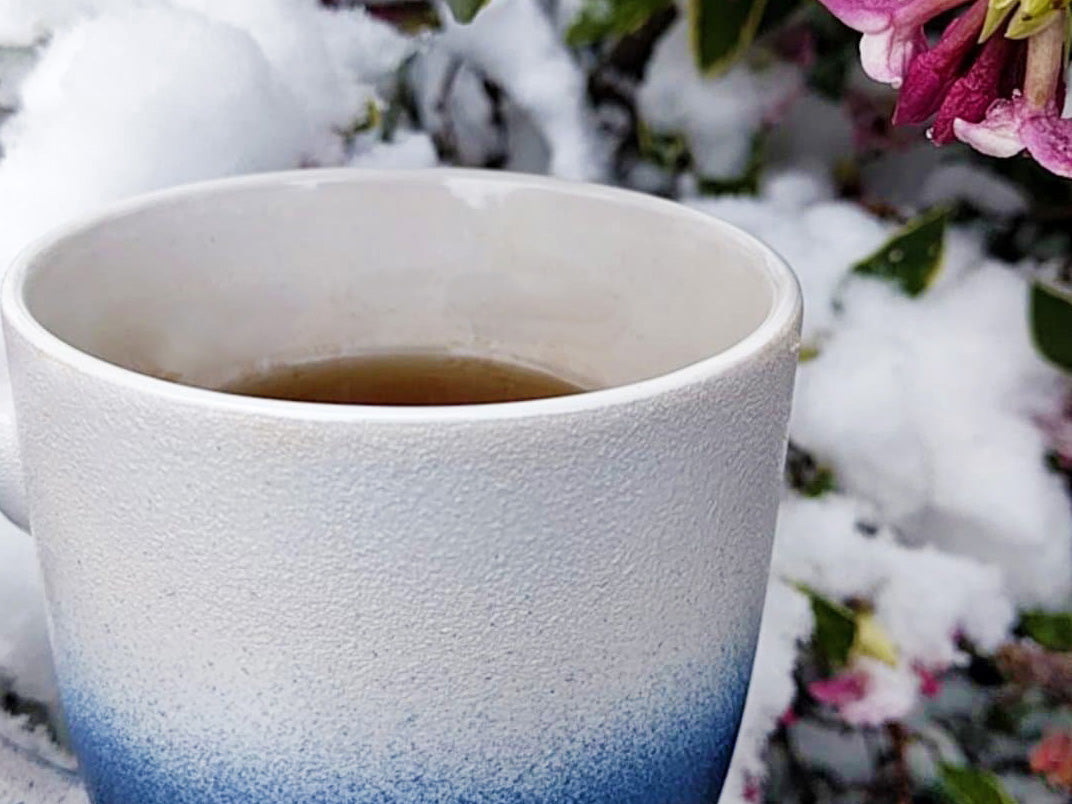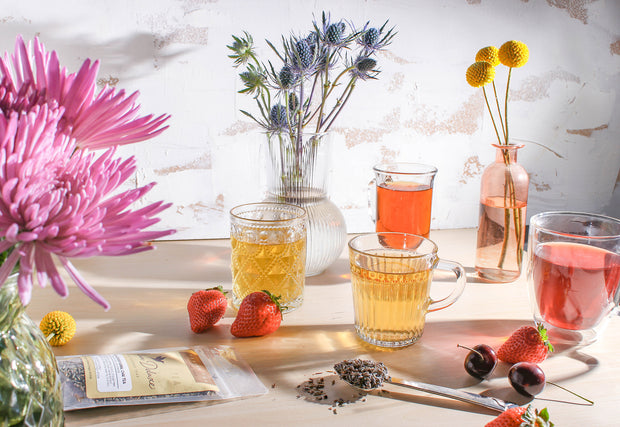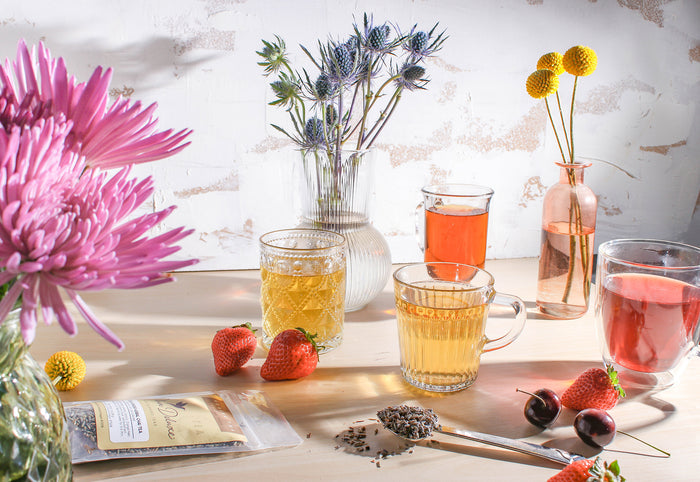
Sun Tea Any Time
There’s a long and lovely tradition of making sun tea in the summertime. It conjures images of lazy, languid days, sipping tawny liquid from the shade of a wrap-around porch.
But luckily for those of us too impatient to wait for the return of warm weather -- and those of us who don’t have a porch even when the temperature does start to climb -- there is no hard and fast rule that says sun tea must be made in the heat of the sun, nor even outside!
Does That Really Count?
Traditionally, sun tea is steeped using sunlight to heat the water, rather than boiling it on the stove. In fact, this doesn’t need to be done in the heat of summer because it doesn’t matter whether the water is warmed at all. (And from a food safety perspective, if you’re not going to boil the water, it’s actually better if it stays cold. More on that in a moment!)
The truth is: tea leaves flavor water. Any temperature, any time.
Adding tea to hot water results in a faster infusion, but the essence of sun tea is all about slowing down. What’s the rush? Just fill your best glass sun tea container with water, add your favorite loose leaf tea, stick it in a sunny spot if you can find one, and let nature do the rest.
Some people may tell you, “That’s not real sun tea.” “That’s a cold brew.” “That’s an infusion.”
I tell you, be free! Live your life and make your tea by your own rules. Which, for those of us living outside of the tropics in January, might involve a cold infusion in a maybe-sun-dappled-but-possibly-rain-cloud-shadowed corner of our kitchen. And who’s to tell us that’s not sun tea?

But Are You Suuuure it Counts?
There are many who insist that you can taste the sun in sun tea; that’s part of what makes the drink magic. Not only is it delicious, as most teas are wont to be, but that ethereal extra ingredient -- a bit of sunshine -- adds a hint of charm that many claim is palpable.
If you fall into that “I swear you can taste the sunshine!” category, don’t worry! Even in winter, you can still harness those sweet rays of sun for all the romance and nostalgia they provide. Simply place your steeping container on a sunny patch of counter space and leave it to bask in the light until your tea has reached the desired strength. I promise, it will count.
Or, if you want to go for the full-blown sun tea feeling, you can leave your container outside for several hours to soak up the full effect of those natural rays. Just be mindful of your environment! If it’s below freezing where you live, your sun tea could become ice tea (not to be confused with iced tea... picture one giant tea-flavored ice cube). If the liquid freezes, there’s a good chance that your glass container will shatter. Not fun.

Safety First: Sun Tea Tips
One of the best parts of making sun tea in the winter is that it’s actually safer than making it in the summer.
Quick science lesson: Bacteria loves conditions between 40 and 140 degrees Fahrenheit -- known in food preparation as “the danger zone.” Making sun tea the traditional way, in full sun heat, will only bring the water to about 130 degrees F -- prime bacteria-growing conditions!
That’s great news for those of us in cold-weather climates who want to learn how to make sun tea in winter. If your thermometer is reading less than 40 degrees outside, that’s ideal for safe tea preparations. (Though it’s still a good idea to follow the safety guidelines below.) Be sure to leave plenty of space in your container to allow the liquid to expand in case of freezing. Remember, you don’t want your glass to shatter!
If you live in an area where “winter weather” and “warm weather” are not mutually exclusive, never fear! You can still make sun tea all year long by following these safety guidelines:
• Sanitize your container. Make sure that your container is as clean as possible before you let your water and tea leaves soak in it for hours. If possible, run it through the dishwasher for an extra-deep cleanse. Hand washing will only get you so far in a battle against bacteria.
• Use a glass jar. If you use plastic instead of glass, you run the risk of chemicals from the plastic seeping into your tea as the container heats. It’s best if the container has a tight-sealing lid rather than something that will leave it exposed to the elements.
• Use purified water. Whenever possible, use filtered or purified water. It significantly decreases your chances of bacteria breeding during the steeping process if your water is as clean as it can be to begin.
• Look for signs of bacteria! Are there white spots? Rope-like strands? That’s bacteria! Toss it out and try again. And be sure to give your container an extra-thorough sanitizing.
• Refrigerate once steeped and drink within a few days. The longer the tea is sitting around at room temperature -- or anywhere between 40 and 140 degrees -- the more likely it is that bacteria will decide that your lovely sun tea is the perfect place to go for a swim. Keep it in the fridge to freeze them out!
While sun tea is a wonderful treat any time of year, bacterial infection is not, so follow these simple guidelines and enjoy your sun tea no matter what the thermometer says.

Favorite Flavors
You can make sun tea with just about anything. If you have a favorite tea, throw it in a glass jar with some water, stick it in a sunny spot, and come back in a few hours. Voila. Sun tea, fun tea.
If, however, you’re looking for some guidelines, black tea is a sun tea classic. You could choose a black tea with fruity notes to really lean into that summer vibe. Wonder-full Pomegranate decaf, Blackberry Mojito, or Smooth Sailing Mango would all make excellent sun tea reminiscent of the laziest, haziest days of summer.
Or you could capture the picturesque nature of sun tea with Porch Sippin’ Pecan black tea -- perfect for lounging around with a nice cuppa, whether on your porch, your apartment balcony, or the comfort of your couch (because, hey, it’s winter, and it’s cold out there).
Personally, my preference would be to embrace the coziness of winter with Comfort Blend black tea, a warming blend of orange and cinnamon, wonderful hot or iced! Bonus: For those of us who like to curl up with our tea just before bed, a non-caffeinated option is also available.
How to Make Sun Tea in Winter
Ingredients:
- 5 tablespoons Comfort Blend black tea, or loose leaf tea of choice
- 2 quarts purified water
- Honey dust or maple dust, if desired*
Directions:
Sanitize your 2-quart glass container. Fill with purified water.
Add tea leaves freely to the water. Note: The more space the leaves have to float, the better! There’s no need to use an infuser or filter bags. Just let the tea swim!
Place container in sunny spot inside or outside (making sure the lid is tightly secured and temperature conditions are safe if steeping outside). Let sit 3-5 hours, or until preferred strength is reached.
Strain, stir in sweetener if desired, and enjoy!
Refrigerate remaining tea and drink within a few days.
*Note, you can use granulated sugar, but it won’t dissolve as well in the cold tea.

![Spring Break Tea Variety Pack [6-Pack Variety of Flavors]](http://www.plumdeluxe.com/cdn/shop/files/spring-break-pack.jpg?v=1740682266&width=165)















